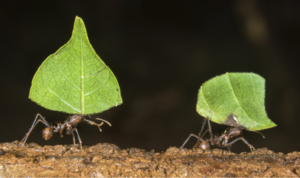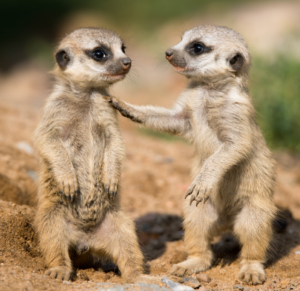Read the Following Selection
Read the following selection, or click on the play button below to listen aloud.
Working Together
Most animals have a natural instinct to survive. (An instinct is a characteristic an animal is born with.) Some animals learn behaviours that will help them survive. All animals need to find food, stay alive in their environment, protect themselves from enemies, and reproduce to survive. Each animal has special characteristics or adaptations to help it survive. Some adaptations are physical—structures on or in the animals’ bodies, such as beaks or colour. Some adaptations are behavioural—things animals do to survive, such as hibernating.
Some animals live in groups and cooperate with the other animals in the group to survive. Common examples of group cooperation are insects that live in colonies, such as bees and ants. All the individuals in these colonies work together for the survival of the colony.
Leaf-Cutter Ants

Leaf-cutter ants are very interesting. The larger ants go out to look for leaves. They bite off bits of leaves and carry them back to the nest. Watching these ants march in a single file, carrying bits of leaves, is quite a sight. These ants can carry a leaf that weighs 20 times more than they do. These larger ants are also responsible for defending the colony from predators.
The leaves the ants collect are not for eating. They are brought back to the colony and tucked away so fungus can grow on them. It is the fungus that is the food for the ants. This fungus is very unusual. It cannot survive outside the colony, and it cannot reproduce without the ants’ help. Smaller ants in the colony grow the fungus on the leaves. They also look after the eggs that the queen ant lays.
Meerkats

Meerkats are another animal that lives in a cooperative group. A meerkat group is called a mob or gang. Meerkats live in underground tunnels and work together to help each other survive in their difficult environment. Meerkats share tasks such as watching their young, looking for enemies (particularly in the sky), and hunting for food. Meerkats are good hunters. When they are hunting smaller animals, they communicate with each other by making purring sounds.
Meerkats share their jobs, unlike leaf-cutter ants that each do only one job. But meerkats and leaf-cutter ants both work together in groups for the survival of all group members.
Now, show what you know!
Complete some questions about the reading selection by clicking “Begin Questions” below.









